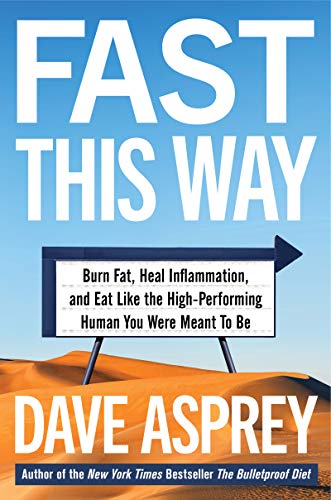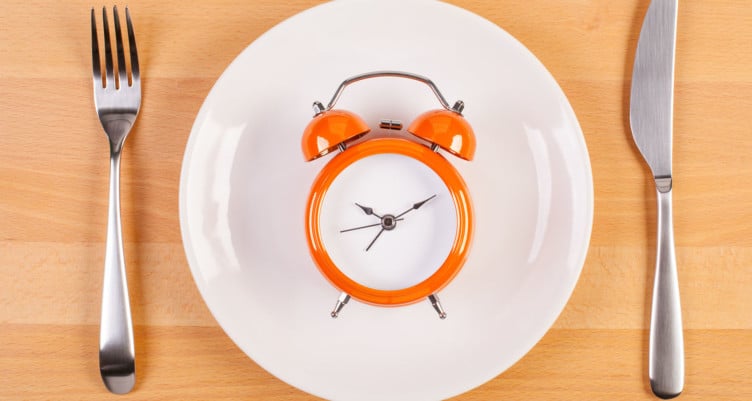
- Intermittent fasting (IF) is an eating style where you eat all your daily calories within a specific time window, then fast the rest of the time.
- IF is a powerful weight loss tool and research shows that it has tons of other benefits, too—like more energy, brain power, and cellular protection.
- There are many different ways to approach intermittent fasting; you can experiment with it and find a style that works for you.
In many ways, intermittent fasting (IF) is the ideal biohack. It’s simple, free, requires no special equipment, and delivers powerful upgrades to your biology, including weight loss, mental clarity, anti-aging benefits, and more.
If you haven’t tried IF before, I have some good news: you can start right now. Keep reading to learn how intermittent fasting can transform your body and brain, and how you can customize it to fit your goals.
What Is Intermittent Fasting?
Intermittent fasting is all about changing your meal timing. During an intermittent fast, you eat all your calories within a shortened eating window—usually 8-10 hours––and then fast for the rest of the day. Here’s what that might look like:
- Skip breakfast.
- At noon, break your fast and have your first meal.
- Eat dinner. Maybe treat yourself to dessert.
- Stop eating by 8 p.m.
- Repeat the next day, with your first meal at noon.
In this example, you eat all your meals in an 8-hour eating window (from 12-8 PM) and fast the other 16 hours of the day, which would be called a 16:8 fast.
It may seem like a small shift, but over time, following a fasting schedule like the one above has big payoffs for your biology.
Benefits of Intermittent Fasting
When you restrict your eating window using IF, you turn on several benefits:
- Weight loss. Research shows that IF is a powerful tool for weight loss. A recent review of 27 studies on intermittent fasting found that people lost significant weight in every single trial[*]. Not only that, but fasting also improved blood sugar control and stabilized insulin, both of which are great for your long-term metabolic health.
- Ketosis. If you eat carbs on a regular basis, your body preferentially uses glucose (carbohydrates) for energy. When you fast, your body uses up available glucose, then switches to burning fat for fuel—putting you in a metabolic state called ketosis. Keto speeds up your metabolism, suppresses hunger, and reduces inflammation[*]. For extra benefits, break your fast with high-fat, low-carb foods to keep ketosis going.
- Mental clarity. Your cells get older and slow down over time. They also produce waste that builds up and interferes with cellular function. Fasting activates autophagy, a process that acts like spring cleaning for your cells. It clears out junk and replaces old or damaged cells, especially in your brain––which could explain why so many people report mental clarity during fasts[*][*].
- Longevity. Animal studies have found that fasting increases lifespan and reduces risk of chronic disease[*][*]. In humans, fasting decreases inflammation and prevents metabolic syndrome, two of the main drivers of aging and disease[*].
The Science of Intermittent Fasting
Intermittent fasting gives your body time to reset. When you take a break between meals, your glucose levels remain stable, your insulin levels drop and, in the absence of calories, your body has a chance to clean up shop (autophagy)—all of which can support major benefits like weight management and longevity.
By the way, this means that you get major benefits from fasting even if you don’t restrict your calories. You can eat the same amount you’re eating now––just change the timing––and you’ll still see benefits from fasting.
How to Start Intermittent Fasting Right Now
IF is simple, free, and easy to start right now.
You can follow the same fasting pattern every day, or you can just fast a couple times a week. You can even customize the amount of time you spend between meals—which is good news if you only want to fast now and then.
Types of Intermittent Fasting
- 16:8. You eat all of your daily calories within an 8-hour window (say, between noon and 8 PM) and fast the rest of the time.
- 20:4. Just like 16:8 fasting, but you eat all your meals in a 4-hour window and fast for 20 hours each day.
- One meal a day (OMAD). You eat all of your daily calories in just one meal each day, and fast the rest of the day.
- Alternate day fasting. You eat nothing every other day (Mon/Wed/Fri, for example) and eat normally on non-fasting days (Tues/Thur/Sat/Sun).
The biggest takeaway here is that there is no one-size-fits-all approach to intermittent fasting. Experiment with a few different routines to the perfect fit, pay attention to how you feel and don’t be afraid to experiment with different schedules.
You can also choose the hours for your eating window. If you love breakfast and don’t want to give it up, you can just switch your fasting period. Eat a full meal around 8 a.m., and stop eating around 4 p.m. You’re still fasting for 16 hours daily (a 16:8 fasting schedule).
Play around with different types of fasting and see what works for you.
Intermittent Fasting Rules
The big rule of fasting is that you don’t eat anything with calories during your fasting period and you consume all your daily calories within your eating window.
That means that you can have zero-calorie drinks during your fasting window, including coffee and tea. Don’t worry––you don’t have to give up your morning cup of joe. In fact, the caffeine in coffee and tea suppresses appetite[*][*], making it easier to fast.
Intermittent Fasting and Calories
One note on calorie intake:
It’s harder to get a full day’s worth of calories into a shortened eating window or a single meal, which is one of the reasons IF is so good for weight loss.
However, it’s also easy to come up short on calories by mistake, or to eat far fewer calories than you intend, even if you are trying to lose weight.
If you’re feeling fatigued, sluggish and not yourself, talk to your doctor and consider using a food tracker app (MyFitnessPal is a good one, and it’s free) to make sure you’re eating enough to stay energized and awesome.
And it’s worth mentioning that intermittent fasting may not work for you, and that’s okay. If you find you don’t feel good going for extended periods without food, skip IF. There are plenty of other biohacks out there.
Your dietary needs depend on your genetics, metabolism, activity level, and a bunch of other factors. Your body will tell you if you need to adjust your intermittent fasting plan, and this eating pattern isn’t for everyone. That’s perfectly okay. What matters is that you’re doing what helps you feel your best, day in and day out.
Advanced Intermittent Fasting
If you want to jump into more advanced IF, check out the Intermittent Fasting Roadmap, it includes a full visual guide to fasting schedules, as well as advanced tips to make your fast even more effective. Join my 14-Day Free Fasting Challenge if you want to be part of a community of over 500K who are on the same journey.
Give IF a try and see how you feel, and play around with different schedules to find one that works for you. Happy fasting!















